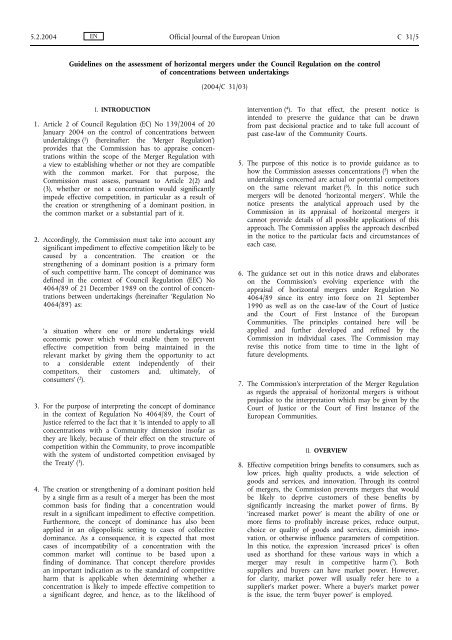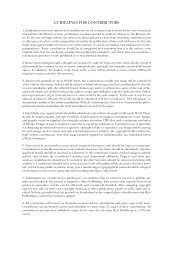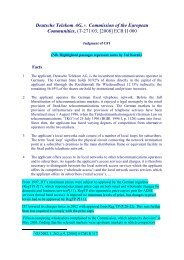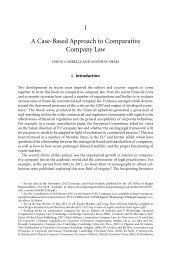Guidelines on the assessment of horizontal mergers ... - EUR-Lex
Guidelines on the assessment of horizontal mergers ... - EUR-Lex
Guidelines on the assessment of horizontal mergers ... - EUR-Lex
- No tags were found...
Create successful ePaper yourself
Turn your PDF publications into a flip-book with our unique Google optimized e-Paper software.
ENC 31/14 Official Journal <strong>of</strong> <strong>the</strong> European Uni<strong>on</strong> 5.2.200482. In <strong>the</strong> c<strong>on</strong>text <strong>of</strong> coordinated effects, efficiencies mayincrease <strong>the</strong> merged entity's incentive to increaseproducti<strong>on</strong> and reduce prices, and <strong>the</strong>reby reduce itsincentive to coordinate its market behaviour with o<strong>the</strong>rfirms in <strong>the</strong> market. Efficiencies may <strong>the</strong>refore lead to alower risk <strong>of</strong> coordinated effects in <strong>the</strong> relevant market.83. In general, <strong>the</strong> later <strong>the</strong> efficiencies are expected tomaterialise in <strong>the</strong> future, <strong>the</strong> less weight <strong>the</strong> Commissi<strong>on</strong>can assign to <strong>the</strong>m. This implies that, in order to bec<strong>on</strong>sidered as a counteracting factor, <strong>the</strong> efficiencies mustbe timely.84. The incentive <strong>on</strong> <strong>the</strong> part <strong>of</strong> <strong>the</strong> merged entity to passefficiency gains <strong>on</strong> to c<strong>on</strong>sumers is <strong>of</strong>ten related to <strong>the</strong>existence <strong>of</strong> competitive pressure from <strong>the</strong> remaining firmsin <strong>the</strong> market and from potential entry. The greater <strong>the</strong>possible negative effects <strong>on</strong> competiti<strong>on</strong>, <strong>the</strong> more <strong>the</strong>Commissi<strong>on</strong> has to be sure that <strong>the</strong> claimed efficienciesare substantial, likely to be realised, and to be passed <strong>on</strong>,to a sufficient degree, to <strong>the</strong> c<strong>on</strong>sumer. It is highly unlikelythat a merger leading to a market positi<strong>on</strong> approachingthat <strong>of</strong> a m<strong>on</strong>opoly, or leading to a similar level <strong>of</strong> marketpower, can be declared compatible with <strong>the</strong> comm<strong>on</strong>market <strong>on</strong> <strong>the</strong> ground that efficiency gains would besufficient to counteract its potential anti-competitiveeffects.c<strong>on</strong>sumers should <strong>the</strong>refore be quantified. When <strong>the</strong>necessary data are not available to allow for a precisequantitative analysis, it must be possible to foresee aclearly identifiable positive impact <strong>on</strong> c<strong>on</strong>sumers, not amarginal <strong>on</strong>e. In general, <strong>the</strong> l<strong>on</strong>ger <strong>the</strong> start <strong>of</strong> <strong>the</strong> efficienciesis projected into <strong>the</strong> future, <strong>the</strong> less probability <strong>the</strong>Commissi<strong>on</strong> may be able to assign to <strong>the</strong> efficienciesactually being brought about.87. Most <strong>of</strong> <strong>the</strong> informati<strong>on</strong>, allowing <strong>the</strong> Commissi<strong>on</strong> toassess whe<strong>the</strong>r <strong>the</strong> merger will bring about <strong>the</strong> sort <strong>of</strong>efficiencies that would enable it to clear a merger, issolely in <strong>the</strong> possessi<strong>on</strong> <strong>of</strong> <strong>the</strong> merging parties. It is,<strong>the</strong>refore, incumbent up<strong>on</strong> <strong>the</strong> notifying parties toprovide in due time all <strong>the</strong> relevant informati<strong>on</strong>necessary to dem<strong>on</strong>strate that <strong>the</strong> claimed efficiencies aremerger-specific and likely to be realised. Similarly, it is for<strong>the</strong> notifying parties to show to what extent <strong>the</strong> efficienciesare likely to counteract any adverse effects <strong>on</strong>competiti<strong>on</strong> that might o<strong>the</strong>rwise result from <strong>the</strong> merger,and <strong>the</strong>refore benefit c<strong>on</strong>sumers.88. Evidence relevant to <strong>the</strong> <strong>assessment</strong> <strong>of</strong> efficiency claimsincludes, in particular, internal documents that were usedby <strong>the</strong> management to decide <strong>on</strong> <strong>the</strong> merger, statementsfrom <strong>the</strong> management to <strong>the</strong> owners and financial marketsabout <strong>the</strong> expected efficiencies, historical examples <strong>of</strong> efficienciesand c<strong>on</strong>sumer benefit, and pre-merger externalexperts' studies <strong>on</strong> <strong>the</strong> type and size <strong>of</strong> efficiency gains,and <strong>on</strong> <strong>the</strong> extent to which c<strong>on</strong>sumers are likely to benefit.Merger specificity85. Efficiencies are relevant to <strong>the</strong> competitive <strong>assessment</strong>when <strong>the</strong>y are a direct c<strong>on</strong>sequence <strong>of</strong> <strong>the</strong> notifiedmerger and cannot be achieved to a similar extent byless anticompetitive alternatives. In <strong>the</strong>se circumstances,<strong>the</strong> efficiencies are deemed to be caused by <strong>the</strong> mergerand thus, merger-specific ( 108 ). It is for <strong>the</strong> mergingparties to provide in due time all <strong>the</strong> relevant informati<strong>on</strong>necessary to dem<strong>on</strong>strate that <strong>the</strong>re are no less anticompetitive,realistic and attainable alternatives <strong>of</strong> an<strong>on</strong>-c<strong>on</strong>centrative nature (e.g. a licensing agreement, or acooperative joint venture) or <strong>of</strong> a c<strong>on</strong>centrative nature (e.g.a c<strong>on</strong>centrative joint venture, or a differently structuredmerger) than <strong>the</strong> notified merger which preserve <strong>the</strong>claimed efficiencies. The Commissi<strong>on</strong> <strong>on</strong>ly c<strong>on</strong>siders alternativesthat are reas<strong>on</strong>ably practical in <strong>the</strong> businesssituati<strong>on</strong> faced by <strong>the</strong> merging parties having regard toestablished business practices in <strong>the</strong> industry c<strong>on</strong>cerned.Verifiability86. Efficiencies have to be verifiable such that <strong>the</strong> Commissi<strong>on</strong>can be reas<strong>on</strong>ably certain that <strong>the</strong> efficiencies are likely tomaterialise, and be substantial enough to counteract amerger's potential harm to c<strong>on</strong>sumers. The more preciseand c<strong>on</strong>vincing <strong>the</strong> efficiency claims are, <strong>the</strong> better <strong>the</strong>Commissi<strong>on</strong> can evaluate <strong>the</strong> claims. Where reas<strong>on</strong>ablypossible, efficiencies and <strong>the</strong> resulting benefit toVIII. FAILING FIRM89. The Commissi<strong>on</strong> may decide that an o<strong>the</strong>rwise problematicmerger is never<strong>the</strong>less compatible with <strong>the</strong>comm<strong>on</strong> market if <strong>on</strong>e <strong>of</strong> <strong>the</strong> merging parties is afailing firm. The basic requirement is that <strong>the</strong> deteriorati<strong>on</strong><strong>of</strong> <strong>the</strong> competitive structure that follows <strong>the</strong> mergercannot be said to be caused by <strong>the</strong> merger ( 109 ). This willarise where <strong>the</strong> competitive structure <strong>of</strong> <strong>the</strong> market woulddeteriorate to at least <strong>the</strong> same extent in <strong>the</strong> absence <strong>of</strong> <strong>the</strong>merger ( 110 ).90. The Commissi<strong>on</strong> c<strong>on</strong>siders <strong>the</strong> following three criteria tobe especially relevant for <strong>the</strong> applicati<strong>on</strong> <strong>of</strong> a ‘failing firmdefence’. First, <strong>the</strong> allegedly failing firm would in <strong>the</strong> nearfuture be forced out <strong>of</strong> <strong>the</strong> market because <strong>of</strong> financialdifficulties if not taken over by ano<strong>the</strong>r undertaking.Sec<strong>on</strong>d, <strong>the</strong>re is no less anti-competitive alternativepurchase than <strong>the</strong> notified merger. Third, in <strong>the</strong> absence<strong>of</strong> a merger, <strong>the</strong> assets <strong>of</strong> <strong>the</strong> failing firm would inevitablyexit <strong>the</strong> market ( 111 ).91. It is for <strong>the</strong> notifying parties to provide in due time all <strong>the</strong>relevant informati<strong>on</strong> necessary to dem<strong>on</strong>strate that <strong>the</strong>deteriorati<strong>on</strong> <strong>of</strong> <strong>the</strong> competitive structure that follows<strong>the</strong> merger is not caused by <strong>the</strong> merger.
EN5.2.2004 Official Journal <strong>of</strong> <strong>the</strong> European Uni<strong>on</strong> C 31/15( 1 ) Council Regulati<strong>on</strong> (EC) No 139/2004 <strong>of</strong> 20 January 2004 (OJ L 24, 29.1.2004, p. 1).( 2 ) Case T-102/96, Gencor v Commissi<strong>on</strong>, [1999] ECR II-753, paragraph 200. See Joined Cases C-68/94 and C-30/95, France and o<strong>the</strong>rs vCommissi<strong>on</strong> (hereinafter ‘Kali and Salz’), [1998] ECR I-1375, paragraph 221. In excepti<strong>on</strong>al circumstances, a merger may give rise to <strong>the</strong>creati<strong>on</strong> or <strong>the</strong> streng<strong>the</strong>ning <strong>of</strong> a dominant positi<strong>on</strong> <strong>on</strong> <strong>the</strong> part <strong>of</strong> an undertaking which is not a party to <strong>the</strong> notified transacti<strong>on</strong> (see CaseIV/M.1383 — Exx<strong>on</strong>/Mobil, points 225-229; Case COMP/M.2434 — Grupo Villar MIR/EnBW/Hidroelectrica del Cantabrico, points 67-71).( 3 ) See also Joined Cases C-68/94 and C-30/95, Kali and Salz, paragraph 170.( 4 ) See Recitals 25 and 26 <strong>of</strong> <strong>the</strong> Merger Regulati<strong>on</strong>.( 5 ) The term ‘c<strong>on</strong>centrati<strong>on</strong>’ used in <strong>the</strong> Merger Regulati<strong>on</strong> covers various types <strong>of</strong> transacti<strong>on</strong>s such as <strong>mergers</strong>, acquisiti<strong>on</strong>s, takeovers, and certaintypes <strong>of</strong> joint ventures. In <strong>the</strong> remainder <strong>of</strong> this notice, unless o<strong>the</strong>rwise specified, <strong>the</strong> term ‘merger’ will be used as a syn<strong>on</strong>ym for c<strong>on</strong>centrati<strong>on</strong>and <strong>the</strong>refore cover all <strong>the</strong> above types <strong>of</strong> transacti<strong>on</strong>s.( 6 ) The notice does not cover <strong>the</strong> <strong>assessment</strong> <strong>of</strong> <strong>the</strong> effects <strong>of</strong> competiti<strong>on</strong> that a merger has in o<strong>the</strong>r markets, including vertical and c<strong>on</strong>glomerateeffects. Nor does it cover <strong>the</strong> <strong>assessment</strong> <strong>of</strong> <strong>the</strong> effects <strong>of</strong> a joint venture as referred to in Article 2(4) <strong>of</strong> <strong>the</strong> Merger Regulati<strong>on</strong>.( 7 ) The expressi<strong>on</strong> should be understood to also cover situati<strong>on</strong>s where, for instance, prices are decreased less, or are less likely to decrease, than <strong>the</strong>yo<strong>the</strong>rwise would have without <strong>the</strong> merger and where prices are increased more, or are more likely to increase, than <strong>the</strong>y o<strong>the</strong>rwise would havewithout <strong>the</strong> merger.( 8 ) By analogy, in <strong>the</strong> case <strong>of</strong> a merger that has been implemented without having been notified, <strong>the</strong> Commissi<strong>on</strong> would assess <strong>the</strong> merger in <strong>the</strong>light <strong>of</strong> <strong>the</strong> competitive c<strong>on</strong>diti<strong>on</strong>s that would have prevailed without <strong>the</strong> implemented merger.( 9 ) See, e.g. Commissi<strong>on</strong> Decisi<strong>on</strong> 98/526/EC in Case IV/M.950 — H<strong>of</strong>fmann La Roche/Boehringer Mannheim, OJ L 234, 21.8.1998, p. 14, point13; Case IV/M.1846 — Glaxo Wellcome/SmithKline Beecham, points 70-72; Case COMP/M.2547 — Bayer/Aventis Crop Science, points 324 etseq.( 10 ) See, e.g. Case T-102/96, Gencor v Commissi<strong>on</strong>, [1999] ECR II-753, paragraphs 247-263.( 11 ) OJ C 372, 9.12.1997, p. 5.( 12 ) See Case T-102/96, Gencor v Commissi<strong>on</strong>, [1999] ECR II-753, paragraph 262, and Case T-342/99, Airtours v Commissi<strong>on</strong>, [2002] ECR II-2585,paragraph 280.( 13 ) As to <strong>the</strong> calculati<strong>on</strong> <strong>of</strong> market shares, see also Commissi<strong>on</strong> Notice <strong>on</strong> <strong>the</strong> definiti<strong>on</strong> <strong>of</strong> <strong>the</strong> relevant market for <strong>the</strong> purposes <strong>of</strong> Communitycompetiti<strong>on</strong> law, OJ C 372, 9.12.1997, p. 3, paragraphs 54-55.( 14 ) See, e.g. Case COMP/M.1806 — Astra Zeneca/Novartis, points 150 and 415.( 15 ) When relevant, market shares may be adjusted, in particular, to account for c<strong>on</strong>trolling interests in o<strong>the</strong>r firms (See, e.g. Case IV/M.1383 —Exx<strong>on</strong>/Mobil, points 446-458; Case COMP/M.1879 — Boeing/Hughes, points 60-79; Case COMP/JV 55 — Hutchis<strong>on</strong>/RCPM/ECT, points 66-75),or for o<strong>the</strong>r arrangements with third parties (See, for instance, as regards sub-c<strong>on</strong>tractors, Commissi<strong>on</strong> Decisi<strong>on</strong> 2001/769/EC in CaseCOMP/M.1940 — Framatome/Siemens/Cogema, OJ L 289, 6.11.2001, p. 8, point 142).( 16 ) See, e.g. Case COMP/M.2256 — Philips/Agilent Health Care Technologies, points 31-32, and Case COMP/M.2609 — HP/Compaq, point 39.( 17 ) See, e.g. Case IV/M.1365 — FCC/Vivendi, point 40; Case COMP/JV 55 — Hutchis<strong>on</strong>/RCPM/ECT, point 50. If appropriate, <strong>the</strong> Commissi<strong>on</strong> mayalso use o<strong>the</strong>r c<strong>on</strong>centrati<strong>on</strong> measures such as, for instance, c<strong>on</strong>centrati<strong>on</strong> ratios, which measure <strong>the</strong> aggregate market share <strong>of</strong> a small number(usually three or four) <strong>of</strong> <strong>the</strong> leading firms in a market.( 18 ) For example, a market c<strong>on</strong>taining five firms with market shares <strong>of</strong> 40 %, 20 %, 15 %, 15 %, and 10 %, respectively, has an HHI <strong>of</strong> 2 550 (40 2 +20 2 + 15 2 + 15 2 + 10 2 = 2 550). The HHI ranges from close to zero (in an atomistic market) to 10 000 (in <strong>the</strong> case <strong>of</strong> a pure m<strong>on</strong>opoly).( 19 ) The increase in c<strong>on</strong>centrati<strong>on</strong> as measured by <strong>the</strong> HHI can be calculated independently <strong>of</strong> <strong>the</strong> overall market c<strong>on</strong>centrati<strong>on</strong> by doubling <strong>the</strong>product <strong>of</strong> <strong>the</strong> market shares <strong>of</strong> <strong>the</strong> merging firms. For example, a merger <strong>of</strong> two firms with market shares <strong>of</strong> 30 % and 15 % respectively wouldincrease <strong>the</strong> HHI by 900 (30 × 15 × 2 = 900). The explanati<strong>on</strong> for this technique is as follows: Before <strong>the</strong> merger, <strong>the</strong> market shares <strong>of</strong> <strong>the</strong>merging firms c<strong>on</strong>tribute to <strong>the</strong> HHI by <strong>the</strong>ir squares individually: (a) 2 + (b) 2 . After <strong>the</strong> merger, <strong>the</strong> c<strong>on</strong>tributi<strong>on</strong> is <strong>the</strong> square <strong>of</strong> <strong>the</strong>ir sum: (a +b) 2 , which equals (a) 2 + (b) 2 + 2ab. The increase in <strong>the</strong> HHI is <strong>the</strong>refore represented by 2ab.( 20 ) Case T-221/95, Endemol v Commissi<strong>on</strong>, [1999] ECR II-1299, paragraph 134, and Case T-102/96, Gencor v Commissi<strong>on</strong>, [1999] ECR II-753,paragraph 205. It is a distinct questi<strong>on</strong> whe<strong>the</strong>r a dominant positi<strong>on</strong> is created or streng<strong>the</strong>ned as a result <strong>of</strong> <strong>the</strong> merger.( 21 ) See, e.g. Case COMP/M.2337 — Nestlé/Ralst<strong>on</strong> Purina, points 48-50.( 22 ) See, e.g. Commissi<strong>on</strong> Decisi<strong>on</strong> 1999/674/EC in Case IV/M.1221 — Rewe/Meinl, OJ L 274, 23.10.1999, p. 1, points 98-114; Case COMP/M.2337— Nestlé/Ralst<strong>on</strong> Purina, points 44-47.( 23 ) The calculati<strong>on</strong> <strong>of</strong> market shares depends critically <strong>on</strong> market definiti<strong>on</strong>. It must be emphasised that <strong>the</strong> Commissi<strong>on</strong> does not necessarily accept<strong>the</strong> parties' proposed market definiti<strong>on</strong>.( 24 ) Recital 32 <strong>of</strong> <strong>the</strong> Merger Regulati<strong>on</strong>. However, such an indicati<strong>on</strong> does not apply to cases where <strong>the</strong> proposed merger creates or streng<strong>the</strong>ns acollective dominant positi<strong>on</strong> involving <strong>the</strong> ‘undertakings c<strong>on</strong>cerned’ and o<strong>the</strong>r third parties (see Joined Cases C-68/94 and C-30/95, Kali and Salz,[1998] ECR I-1375, paragraphs 171 et seq.; and Case T-102/96, Gencor v Commissi<strong>on</strong>, [1999] ECR II-753, paragraphs 134 et seq.).( 25 ) In markets with cross-shareholdings or joint ventures <strong>the</strong> Commissi<strong>on</strong> may use a modified HHI, which takes into account such share-holdings(see, e.g. Case IV/M.1383 — Exx<strong>on</strong>/Mobil, point 256).
ENC 31/16 Official Journal <strong>of</strong> <strong>the</strong> European Uni<strong>on</strong> 5.2.2004( 26 ) See paragraph 17.( 27 ) Also <strong>of</strong>ten called ‘unilateral’ effects.( 28 ) Such expected reacti<strong>on</strong>s by competitors may be a relevant factor influencing <strong>the</strong> merged entity's incentives to increase prices.( 29 ) An oligopolistic market refers to a market structure with a limited number <strong>of</strong> sizeable firms. Because <strong>the</strong> behaviour <strong>of</strong> <strong>on</strong>e firm has anappreciable impact <strong>on</strong> <strong>the</strong> overall market c<strong>on</strong>diti<strong>on</strong>s, and thus indirectly <strong>on</strong> <strong>the</strong> situati<strong>on</strong> <strong>of</strong> each <strong>of</strong> <strong>the</strong> o<strong>the</strong>r firms, oligopolistic firms areinterdependent.( 30 ) Recital 25 <strong>of</strong> <strong>the</strong> Merger Regulati<strong>on</strong>.( 31 ) See, in particular, paragraphs 17 and 18.( 32 ) Products may be differentiated in various ways. There may, for example, be differentiati<strong>on</strong> in terms <strong>of</strong> geographic locati<strong>on</strong>, based <strong>on</strong> branch orstores locati<strong>on</strong>; locati<strong>on</strong> matters for retail distributi<strong>on</strong>, banks, travel agencies, or petrol stati<strong>on</strong>s. Likewise, differentiati<strong>on</strong> may be based <strong>on</strong> brandimage, technical specificati<strong>on</strong>s, quality or level <strong>of</strong> service. The level <strong>of</strong> advertising in a market may be an indicator <strong>of</strong> <strong>the</strong> firms' effort todifferentiate <strong>the</strong>ir products. For o<strong>the</strong>r products, buyers may have to incur switching costs to use a competitor's product.( 33 ) For <strong>the</strong> definiti<strong>on</strong> <strong>of</strong> <strong>the</strong> relevant market, see <strong>the</strong> Commissi<strong>on</strong>'s Notice <strong>on</strong> <strong>the</strong> definiti<strong>on</strong> <strong>of</strong> <strong>the</strong> relevant market for <strong>the</strong> purposes <strong>of</strong> Communitycompetiti<strong>on</strong> law, cited above.( 34 ) See for example Case COMP/M.2817 — Barilla/BPS/Kamps, point 34; Commissi<strong>on</strong> Decisi<strong>on</strong> 2001/403/EC in Case COMP/M.1672 — Volvo/Scania, OJ L 143, 29.5.2001, p. 74, points 107-148.( 35 ) See, e.g. Commissi<strong>on</strong> Decisi<strong>on</strong> 94/893/EC in Case IV/M.430 — Procter & Gamble/VP Schickedanz (II), OJ L 354, 21.6.1994, p. 32, CaseT-290/94, Kaysersberg v Commissi<strong>on</strong>, [1997] II-2137, paragraph 153; Commissi<strong>on</strong> Decisi<strong>on</strong> 97/610/EC in Case IV/M.774 — Saint-Gobain/Wacker-Chemie/NOM, OJ L 247, 10.9.1997, p. 1, point 179; Commissi<strong>on</strong> Decisi<strong>on</strong> 2002/156/EC in Case COMP/M.2097 — SCA/Metsä Tissue,OJ L 57, 27.2.2002, p. 1, points 94-108; Case T-310/01, Schneider v Commissi<strong>on</strong>, [2002] II-4071, paragraph 418.( 36 ) Typically, <strong>the</strong> relevant margin (m) is <strong>the</strong> difference between price (p) and <strong>the</strong> incremental cost (c) <strong>of</strong> supplying <strong>on</strong>e more unit <strong>of</strong> output expressedas a percentage <strong>of</strong> price (m = (p - c)p)).( 37 ) See, e.g. Case IV/M.1980 — Volvo/Renault VI, point 34; Case COMP/M.2256 — Philips Agilent/Health Care Soluti<strong>on</strong>s, points 33-35; CaseCOMP/M.2537 — Philips/Marc<strong>on</strong>i Medical Systems, points 31-34.( 38 ) The cross-price elasticity <strong>of</strong> demand measures <strong>the</strong> extent to which <strong>the</strong> quantity <strong>of</strong> a product demanded changes in resp<strong>on</strong>se to a change in <strong>the</strong>price <strong>of</strong> some o<strong>the</strong>r product, all o<strong>the</strong>r things remaining equal. The own-price elasticity measures <strong>the</strong> extent to which demand for a productchanges in resp<strong>on</strong>se to <strong>the</strong> change in <strong>the</strong> price <strong>of</strong> <strong>the</strong> product itself.( 39 ) The diversi<strong>on</strong> ratio from product A to product B measures <strong>the</strong> proporti<strong>on</strong> <strong>of</strong> <strong>the</strong> sales <strong>of</strong> product A lost due to a price increase <strong>of</strong> A that arecaptured by product B.( 40 ) Commissi<strong>on</strong> Decisi<strong>on</strong> 97/816/EC in Case IV/M.877 — Boeing/McD<strong>on</strong>nell Douglas, OJ L 336, 8.12.1997, p. 16, points 58 et seq.; CaseCOMP/M.3083 — GE/Instrumentarium, points 125 et seq.( 41 ) Sunk costs are costs which are unrecoverable up<strong>on</strong> exit from <strong>the</strong> market.( 42 ) See e.g. Commissi<strong>on</strong> Decisi<strong>on</strong> 2002/156/EC in Case IV/M.877 — Boeing/McD<strong>on</strong>nell Douglas, OJ L 336, 8.12.1997, p. 16, point 70.( 43 ) See, e.g. Case IV/M. 986 — Agfa Gevaert/DuP<strong>on</strong>t, OJ L 211, 29.7.1998, p. 22, points 63-71.( 44 ) See, e.g. Case COMP/M.2187 — CVC/Lenzing, points 162-170.( 45 ) When analysing <strong>the</strong> possible expansi<strong>on</strong> <strong>of</strong> capacity by rivals, <strong>the</strong> Commissi<strong>on</strong> c<strong>on</strong>siders factors similar to those described in Secti<strong>on</strong> VI <strong>on</strong> entry.See, e.g. Case COMP/M.2187 — CVC/Lenzing, points 162-173.( 46 ) See, e.g. Case T-221/95, Endemol v Commissi<strong>on</strong>, [1999] ECR II-1299, paragraph 167.( 47 ) See, e.g. Case T-22/97, Kesko v Commissi<strong>on</strong>, [1999], ECR II-3775, paragraphs 141 et seq.( 48 ) See, e.g. Commissi<strong>on</strong> Decisi<strong>on</strong> 2001/684/EC in Case M.1671 — Dow Chemical/Uni<strong>on</strong> Carbide OJ L 245, 14.9.2001, p. 1, points 107-114.( 49 ) See, e.g. Commissi<strong>on</strong> Decisi<strong>on</strong> 96/435/EC in Case IV/M.623 — Kimberly-Clark/Scott, OJ L 183, 23.7.1996, p. 1; Case T-114/02, Babyliss SA vCommissi<strong>on</strong> (‘Seb/Moulinex’), [2003] ECR II-000, paragraphs 343 et seq.( 50 ) This is, for example, <strong>the</strong> case in network industries such as energy, telecommunicati<strong>on</strong>s and o<strong>the</strong>r communicati<strong>on</strong> industries.( 51 ) Commissi<strong>on</strong> Decisi<strong>on</strong> 99/287/EC in Case IV/M.1069 — Worldcom/MCI, OJ L 116, 4.5.1999, p. 1, points 117 et seq.; Case IV/M.1741 — MCIWorldcom/Sprint, points 145 et seq.; Case IV/M.1795 — Vodaf<strong>on</strong>e Airtouch/Mannesmann, points 44 et seq.( 52 ) Case T-156/98 RJB Mining v Commissi<strong>on</strong> [2001] ECR II-337.( 53 ) Commissi<strong>on</strong> Decisi<strong>on</strong> 2002/156/EC in Case IV/M.877 — Boeing/McD<strong>on</strong>nell Douglas, OJ L 336, 8.12.1997, p. 16, point 58; Case COMP/M.2568— Haniel/Yt<strong>on</strong>g, point 126.( 54 ) For an example <strong>of</strong> pipeline products <strong>of</strong> <strong>on</strong>e merging party likely to compete with <strong>the</strong> o<strong>the</strong>r party's pipeline or existing products, see, e.g. CaseIV/M.1846 — Glaxo Wellcome/SmithKline Beecham, point 188.( 55 ) Case T-102/96, Gencor v Commissi<strong>on</strong>, [1999] ECR II-753, paragraph 277; Case T-342/99, Airtours v Commissi<strong>on</strong>, [2002] ECR II-2585,paragraph 61.( 56 ) This may be <strong>the</strong> case if <strong>the</strong> oligopolists have tended to c<strong>on</strong>centrate <strong>the</strong>ir sales in different areas for historic reas<strong>on</strong>s.
EN5.2.2004 Official Journal <strong>of</strong> <strong>the</strong> European Uni<strong>on</strong> C 31/17( 57 ) Case T-342/99, Airtours v Commissi<strong>on</strong>, [2002] ECR II-2585, paragraph 62.( 58 ) See Commissi<strong>on</strong> Decisi<strong>on</strong> 92/553/EC in Case IV/M.190 — Nestlé/Perrier, OJ L 356, 5.12.1992, p. 1, points 117-118.( 59 ) See, e.g. Case IV/M.580 — ABB/Daimler-Benz, point 95.( 60 ) See, e.g. Commissi<strong>on</strong> Decisi<strong>on</strong> 2002/156/EC in Case COMP/M.2097 — SCA/Metsä Tissue, OJ L 57, 27.2.2002, p. 1, point 148.( 61 ) See, e.g. Case IV/M.1298 — Kodak/Imati<strong>on</strong>, point 60.( 62 ) Case T-102/96, Gencor v Commissi<strong>on</strong>, [1999] ECR II-753, paragraph 222; Commissi<strong>on</strong> Decisi<strong>on</strong> 92/553/EC in Case IV/M.190 — Nestlé/Perrier,OJ L 356, 5.12.1992, p. 1, points 63-123.( 63 ) In assessing whe<strong>the</strong>r or not a merger may increase <strong>the</strong> symmetry <strong>of</strong> <strong>the</strong> various firms present <strong>on</strong> <strong>the</strong> market, efficiency gains may provideimportant indicati<strong>on</strong>s (see also paragraph 82 <strong>of</strong> <strong>the</strong> notice).( 64 ) See, e.g. Commissi<strong>on</strong> Decisi<strong>on</strong> 2001/519/EC in Case COMP/M.1673 — VEBA/VIAG, OJ L 188, 10.7.2001, p. 1, point 226; Case COMP/M.2567— Nordbanken/Postgirot, point 54.( 65 ) See, e.g. Case COMP/M.2389 — Shell/DEA, points 112 et seq.; and Case COMP/M.2533 — BP/E.ON, points 102 et seq.( 66 ) See also Commissi<strong>on</strong> Decisi<strong>on</strong> 2000/42/EC in Case IV/M.1313 — Danish Crown/Vestjyske Slagterier, OJ L 20, 25.1.2000, p. 1, points 176-179.( 67 ) See, e.g. Case COMP/M.2640 — Nestlé/Schöller, point 37; Commissi<strong>on</strong> Decisi<strong>on</strong> 1999/641/EC in Case COMP/M.1225 — Enso/Stora, OJ L 254,29.9.1999, p. 9, points 67-68.( 68 ) See, e.g. Case IV/M.1939 — Rexam (PLM)/American Nati<strong>on</strong>al Can, point 24.( 69 ) See Case COMP/M.2389 — Shell/DEA, point 121, and Case COMP/M.2533 — BP/E.ON, point 111.( 70 ) Although deterrent mechanisms are sometimes called ‘punishment’ mechanisms, this should not be understood in <strong>the</strong> strict sense that such amechanism necessarily punishes individually a firm that has deviated. The expectati<strong>on</strong> that coordinati<strong>on</strong> may break down for a certain period <strong>of</strong>time, if a deviati<strong>on</strong> is identified as such, may in itself c<strong>on</strong>stitute a sufficient deterrent mechanism.( 71 ) See, e.g. Commissi<strong>on</strong> Decisi<strong>on</strong> 2000/42/EC in Case IV/M.1313 — Danish Crown/Vestjyske Slagterier, OJ L 20, 25.1.2000, p. 1, point 177.( 72 ) See Case T-102/96, Gencor v Commissi<strong>on</strong>, [1999] ECR II-753, paragraph 281.( 73 ) These elements are analysed in a similar way to n<strong>on</strong>-coordinated effects.( 74 ) See, e.g. Case IV/M.1630 — Air Liquide/BOC, points 201 et seq. For an example <strong>of</strong> a case where entry by <strong>the</strong> o<strong>the</strong>r merging firm was notsufficiently likely in <strong>the</strong> short to medium term (Case T-158/00, ARD v Commissi<strong>on</strong>, [2003] ECR II-000, paragraphs 115-127).( 75 ) Commissi<strong>on</strong> Decisi<strong>on</strong> 2001/98/EC in Case IV/M.1439 — Telia/Telenor, OJ L 40, 9.2.2001, p. 1, points 330-331, and Case IV/M.1681 — AkzoNobel/Hoechst Roussel Vet, point 64.( 76 ) Case IV/M.1630 — Air Liquide/BOC, point 219; Commissi<strong>on</strong> Decisi<strong>on</strong> 2002/164/EC in Case COMP/M.1853 — EDF/EnBW, OJ L 59, 28.2.2002,p. 1, points 54-64.( 77 ) See Commissi<strong>on</strong> Decisi<strong>on</strong> 1999/674/EC in Case M.1221 — Rewe/Meinl, OJ L 274, 23.10.1999, p. 1, points 71-74.( 78 ) Case T-22/97, Kesko v Commissi<strong>on</strong>, [1999] ECR II-3775, paragraph 157; Commissi<strong>on</strong> Decisi<strong>on</strong> 2002/156/EC in Case M.877 — Boeing/McD<strong>on</strong>nell Douglas, OJ L 336, 8.12.1997, p. 16, points 105-108.( 79 ) See, e.g. Case IV/M.1882 — Pirelli/BICC, points 73-80.( 80 ) See, e.g. Case IV/M.1245 — Valeo/ITT Industries, point 26.( 81 ) Even a small number <strong>of</strong> customers may not have sufficient buyer power if <strong>the</strong>y are to a large extent ‘locked in’ because <strong>of</strong> high switching costs(see Case COMP/M.2187 — CVC/Lenzing, point 223).( 82 ) Commissi<strong>on</strong> Decisi<strong>on</strong> 1999/641/EC in Case COMP/M.1225 — Enso/Stora, OJ L 254, 29.9.1999, p. 9, points 89-91.( 83 ) It may also be appropriate to compare <strong>the</strong> c<strong>on</strong>centrati<strong>on</strong> existing <strong>on</strong> <strong>the</strong> customer side with <strong>the</strong> c<strong>on</strong>centrati<strong>on</strong> <strong>on</strong> <strong>the</strong> supply side (Case COMP/JV55 — Hutchis<strong>on</strong>/RCPM/ECT, point 119, and Commissi<strong>on</strong> Decisi<strong>on</strong> 1999/641/EC in Case COMP/M.1225 — Enso/Stora, OJ L 254, 29.9.1999, p.9, point 97).( 84 ) Case COMP/JV 55 — Hutchis<strong>on</strong>/RCPM/ECT, points 129-130.( 85 ) Commissi<strong>on</strong> Decisi<strong>on</strong> 2002/156/EC in Case COMP/M.2097 — SCA/Metsä Tissue, OJ L 57, 27.2.2002, point 88. Price discriminati<strong>on</strong> betweendifferent categories <strong>of</strong> customers may be relevant in some cases in <strong>the</strong> c<strong>on</strong>text <strong>of</strong> market definiti<strong>on</strong> (See <strong>the</strong> Commissi<strong>on</strong>'s notice <strong>on</strong> <strong>the</strong> definiti<strong>on</strong><strong>of</strong> <strong>the</strong> relevant market, cited above, at paragraph 43).( 86 ) Accordingly, <strong>the</strong> Commissi<strong>on</strong> may assess whe<strong>the</strong>r <strong>the</strong> various purchasers will hold countervailing buyer power, see, e.g. Commissi<strong>on</strong> Decisi<strong>on</strong>1999/641/EC in Case COMP/M.1225 — Enso/Stora, OJ L 254, 29.9.1999, p. 9, points 84-97.( 87 ) Commissi<strong>on</strong> Decisi<strong>on</strong> 97/610/EC in Case IV/M.774 — Saint-Gobain/Wacker-Chemie/NOM, OJ L 247, 10.9.1997, p. 1, point 184.( 88 ) Case IV/M.1430 — Vodaf<strong>on</strong>e/Airtouch, point 27; Case IV/M.2016 — France Télécom/Orange, point 33.( 89 ) Commissi<strong>on</strong> Decisi<strong>on</strong> 2002/174/EC in Case COMP/M.1693 — Alcoa/Reynolds, OJ L 58, 28.2.2002, point 87.( 90 ) Commissi<strong>on</strong> Decisi<strong>on</strong> 95/335/EC in Case IV/M.754 — Anglo American Corp./L<strong>on</strong>rho, OJ L 149, 20.5.1998, p. 21, points 118-119.( 91 ) Commissi<strong>on</strong> Decisi<strong>on</strong> 97/610/EC in Case IV/M.774 — Saint-Gobain/Wacker-Chemie/NOM, OJ L 247, 10.9.1997, p. 1, points 184-187.( 92 ) Commissi<strong>on</strong> Decisi<strong>on</strong> 94/811/EC in Case IV/M.269 — Shell/M<strong>on</strong>tecatini, OJ L 332, 22.12.1994, p. 48, point 32.
ENC 31/18 Official Journal <strong>of</strong> <strong>the</strong> European Uni<strong>on</strong> 5.2.2004( 93 ) Commissi<strong>on</strong> Decisi<strong>on</strong> 98/327/EC in Case IV/M.833 — The Coca-Cola Company/Carlsberg A/S, OJ L 145, 15.5.1998, p. 41, point 74.( 94 ) Commissi<strong>on</strong> Decisi<strong>on</strong> 98/327/EC in Case IV/M.833 — The Coca-Cola Company/Carlsberg A/S, OJ L 145, 15.5.1998, p. 41, points 72-73.( 95 ) Commissi<strong>on</strong> Decisi<strong>on</strong> 2002/156/EC in Case COMP/M.2097 — SCA/Metsä Tissue, OJ L 57, 27.2.2002, p. 1, points 83-84.( 96 ) Commissi<strong>on</strong> Decisi<strong>on</strong> 2001/432/EC in Case IV/M.1813 — Industri Kapital Nordkem/Dyno, OJ L 154, 9.6.2001, p. 41, point 100.( 97 ) See, e.g. Commissi<strong>on</strong> Decisi<strong>on</strong> 98/475/EC in Case IV/M.986 — Agfa-Gevaert/Dup<strong>on</strong>t, OJ L 211, 29.7.1998, p. 22, points 84-85.( 98 ) Case T-102/96, Gencor v Commissi<strong>on</strong>, [1999] ECR II-753, paragraph 237.( 99 ) See, e.g. Commissi<strong>on</strong> Decisi<strong>on</strong> 2000/718/EC in Case IV/M.1578 — Sanitec/Sphinx, OJ L 294, 22.11.2000, p. 1, point 114.( 100 ) See, e.g. Commissi<strong>on</strong> Decisi<strong>on</strong> 2002/174/EC in Case COMP/M.1693 — Alcoa/Reynolds, L 58, 28.2.2002, points 31-32, 38.( 101 ) Commissi<strong>on</strong> Decisi<strong>on</strong> 91/535/EEC in Case IV/M.68 — Tetra Pak/Alfa Laval, OJ L 290, 22.10.1991, p. 35, point 3.4.( 102 ) See Recital 4 <strong>of</strong> <strong>the</strong> Merger Regulati<strong>on</strong>.( 103 ) See Recital 29 <strong>of</strong> <strong>the</strong> Merger Regulati<strong>on</strong>.( 104 ) Cf. Article 2(1)(b) <strong>of</strong> <strong>the</strong> Merger Regulati<strong>on</strong>.( 105 ) Pursuant to Article 2(1)(b), <strong>the</strong> c<strong>on</strong>cept <strong>of</strong> ‘c<strong>on</strong>sumers’ encompasses intermediate and ultimate c<strong>on</strong>sumers, i.e. users <strong>of</strong> <strong>the</strong> products covered by<strong>the</strong> merger. In o<strong>the</strong>r words, c<strong>on</strong>sumers within <strong>the</strong> meaning <strong>of</strong> this provisi<strong>on</strong> include <strong>the</strong> customers, potential and/or actual, <strong>of</strong> <strong>the</strong> parties to <strong>the</strong>merger.( 106 ) Variable costs should be viewed as those costs that vary with <strong>the</strong> level <strong>of</strong> producti<strong>on</strong> or sales over <strong>the</strong> relevant time period. Marginal costs arethose costs associated with expanding producti<strong>on</strong> or sales at <strong>the</strong> margin.( 107 ) Generally, fixed cost savings are not given such weight as <strong>the</strong> relati<strong>on</strong>ship between fixed costs and c<strong>on</strong>sumer prices is normally less direct, at leastin <strong>the</strong> short run.( 108 ) In line with <strong>the</strong> general principle set out in paragraph 9 <strong>of</strong> this notice.( 109 ) Joined Cases C-68/94 and C-30/95, Kali and Salz, paragraph 110.( 110 ) Joined Cases C-68/94 and C-30/95, Kali and Salz, paragraph 114. See also Commissi<strong>on</strong> Decisi<strong>on</strong> 2002/365/EC in Case COMP/M.2314 —BASF/Pantochim/Eurodiol, OJ L 132, 17.5.2002, p. 45, points 157-160. This requirement is linked to <strong>the</strong> general principle set out in paragraph9 <strong>of</strong> this notice.( 111 ) The inevitability <strong>of</strong> <strong>the</strong> assets <strong>of</strong> <strong>the</strong> failing firm leaving <strong>the</strong> market in questi<strong>on</strong> may, in particular in a case <strong>of</strong> merger to m<strong>on</strong>opoly, underlie afinding that <strong>the</strong> market share <strong>of</strong> <strong>the</strong> failing firm would in any event accrue to <strong>the</strong> o<strong>the</strong>r merging party. See Joined Cases C-68/94 and C-30/95,Kali and Salz, paragraphs 115-116.








